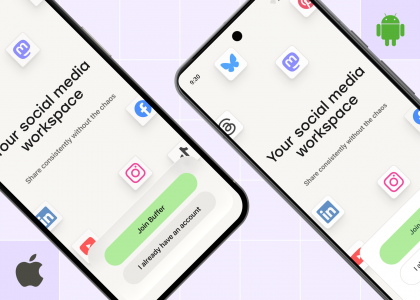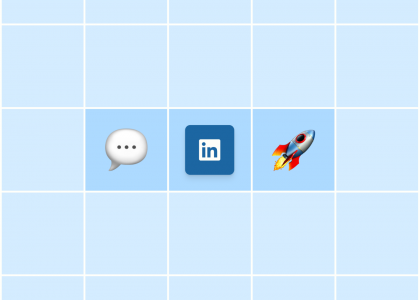You can’t go on vacation these days without seeing someone on their e-reader.
And that’s fantastic news for ebook creators. The ebook market should hit $14 billion in the U.S. alone by the end of this year. It will expand to an expected global market of 1.1 billion readers by 2027.
But even in a hefty market like that, success isn’t guaranteed.
If you want to sell ebooks in this climate, you’ll need to stand out from the other sellers. You’ll need to know how to position and persuade people to buy your book.
We’ve previously tackled how to create a successful ebook. Now it’s time to talk about market liftoff.
How can you sell your book online? How can you distinguish it from others already on sale? How can you ask for a price people are willing to pay?
To learn that, let’s tackle the best strategies for selling your ebook in the current marketplace:
First things first: creating your ebook
Have you created your ebook yet?
No? Here are a few quick reminders from our post about building an ebook for the first time:
Position your ebook by starting with your market and your idea. Is it fiction or nonfiction? Who is your ideal customer?
Outline and draft your ebook with the help of AI writing tools. You can also draft the ebook yourself, or simply hire out the work to a ghostwriter on Fiverr or Upwork.
Build your ebook with tools like Calibre, Reedsy, or Canva so it’s ready to publish in the format of your choice.
Your ebook should hit on a key pain point for your readers. Consider Paula Rizzo, whose book Listful Thinking tackles a specific subject: using lists to get organized.
Still with us so far?
Good. Because once you’ve worked through those tips, you’ll have a shiny new ebook in your hands—digitally speaking—that’s ready to sell.
For many, this is the fun part.
Building a cover to make your ebook’s “pitch”
If you handle your cover right, a sale could happen in an instant. A customer only has to think: “Hmm…that looks good.”
It’s a simple fact of life. Readers do judge books by their covers.
A good title—like “The Joy of Cooking,” with the font placing emphasis on “joy”—should immediately fill the hunger pangs of your ideal reader.
But beyond the title, your cover has to do an effective job of conveying what’s inside. Consider:
Color palette: Colors impact our perception of what’s inside the book. Study color psychology to harmonize what’s on the front and the promise your ebook is making. For instance, a color like green works for books about health, fertility, shedding stress, nature, and gardening.
Typography: Font size, style, and positioning all weigh into the messaging of the book. Serif fonts, says Kindlepreneur, tend to be best for traditional themes. Scripts—fonts that look like penmanship—are best for memoirs and passion projects.
Eye-catchers: What’s the chief element of your book cover? Maybe the title takes up most of the space. Other elements—like flowers in a book on gardening—should have immediate appeal to your target audience.
Space: Finally, pay attention to the use of space—including empty space. There’s only so much real estate on a book cover you can use before it gets crowded.
Platforms for selling ebooks
Once you have your ebook—and a cover to help sell it—your next step is to make it easy to download.
Enter the ebook platform.
Major platforms like Amazon KDP (Kindle Direct Publishing) and Apple Books are great starting places. They’re where many voracious ebook consumers turn to fill their e-readers.
Before you market your book, remember that old show business adage: 90% of success is showing up. Let’s explore what it means for your ebook to “show up” by maximizing your exposure to the top platforms:
Amazon: Amazon KDP is one of the largest marketplaces for ebooks in the entire world. Every year, almost 500 million ebooks go through Amazon.
It features a dashboard for monitoring your sales. And you’ll have power over how you sell your book. Title, cover, price, advertising, category: it’s all under your direct control
Apple: Apple Books, sometimes known as the iBooks store in the past, may be your primary conduit to people who swear by their iPhones and Macs. You’ll earn 70% royalties here on your self-published work—about industry standard.
To kick off the process of publishing, head to their Authors section. There you can start to build your book’s presence in the Apple world and measure your long-term success.
Smashwords: There have been over 31 million ebooks published on Smashwords. And the fun thing about Smashwords is how it’s built for the ebook market.
Smashwords features extensive categories in both fiction and non-fiction. You shouldn’t find it too difficult to find your ebook’s home, no matter your category.
It’s also common to see ebooks fetch as much as $9.99 and up on the platform, which puts your book in an advantageous pricing context.
Kobo: Kobo Writing Life is a great “gateway” for writers who want to focus less on selling and more on writing. If you have your ebook file ready, it just takes a few short steps after signup to have it ready to sell on the platform.
The downside? You might give up a little control. Amazon Kindle Direct Publishing, for example, offers you all sorts of variables to control.
If you find all of that overwhelming, try getting on Kobo as a “gateway” to the rest of the other platforms.
Google: Google Play is the main marketplace app on Android phones, which is why Google Play Books is the key touchpoint here.
It’s especially useful for people who want to target customers who love to read on their phones. That number eclipsed 50% of readers in the mid-2010s. And as phones only become more ubiquitous, you should consider Google Play Books an essential platform.
Draft 2 Digital: How about a self-publishing platform that handles other platforms for you? Draft 2 Digital offers a distribution service for getting your ebook out to multiple ebook storefronts worldwide.
If you prefer the hands-off approach to publishing, it may be the platform for you.
The downside is cost: Draft 2 Digital will take a 10% fee for the retail price of your book in each sale. But it also has no upfront charges and lets you continue to edit your book without additional fees.
Lulu: Lulu is especially popular as a print-on-demand service, but it also offers services for ebook publishing. Their guides and templates constitute a beginner’s “toolkit” that can serve as a handy introduction for anyone who’s breaking into ebook publishing for the first time.
Gumroad: Thanks to its popularity for social media creators, such as those on Twitter, Gumroad is a platform that works great for publishing info products. Gumroad’s easy-download interface requires minimal signup friction from the buyer’s perspective, which is essential for turning engaged followers into customers.
AWeber: Build a landing page with AWeber and you’ll essentially build your own ebook selling platform. Because AWeber isn’t a marketplace, you will have to build an audience, too. But the advantage is that AWeber won’t ask for a cut of every ebook sale via royalties.
How to get readers to want to buy your ebook
The number one challenge for ebook creators isn’t getting their ebooks online. It’s convincing people that their ebook is a must-purchase.
If you’ve already positioned your ebook appropriately, you’ll have done some of the legwork already. But if you want people to pay what you ask, you should learn another aspect of customer psychology: pricing.
Pricing your ebook
After the cover of your book, what’s the second thing most customers look at? Dollars and cents. They need to know what the words inside your book are going to run them.
Pricing an ebook always happens in context. $9.99? Cheap—until you’re next to someone charging $7.49 for theirs.
On the other hand, a hardcover cookbook that costs $40 might not make readers bat an eye. Not when there are other cookbooks on the shelves that cost $50.
So how do you make context work in your favor? Here are a few ways:
Conduct research into your niche. Use the platforms listed above, especially Amazon and Smashwords, to browse what ebooks cost within your niche. For example, a look at “featured new releases” in the Health category on Smashwords shows books from $0.99-$4.99. $1.99 is common here, and likely a good price point.
Look for long-lasting prices. Don’t just browse the new releases, either. Look for prices on bestsellers and books that have been listed for weeks, even months. If the price is working for other sellers in your niche, it can probably work for you.
Pricing psychology tips
Just as there’s a lot of psychology to your book cover, pricing psychology can be downright complex. Consider the following:
Charm pricing: Ebooks often sell for $0.99, $1.99, and $4.99 for a reason. Dropping the price by one cent does make a difference, dropping the first number your customer sees by one. When you shop, your eye gravitates toward $1.99 rather than $2.03.
Tease pricing: This is the same concept behind launching a lead magnet. For example, author Eric R. Asher offers a free novella to people just for signing up for his newsletter. This helps him build an audience, which generates interest when it’s time to sell his full-length novels.
Create your context: You might have heard of this strategy in restaurants. A “wine list” might include low-end and high-end wines—with the idea that a discerning customer will want to choose the relative bargain of the medium-priced wine. You can “create your own” context similarly by offering multiple ebooks for sale at different price points
Go for an aspirational price: If you’re selling comprehensive info products, you might also consider redefining it not as an ebook, but as a full-length course. Package it with other elements on Gumroad like videos, and you can charge much more. As with wine, a higher price often gets customers to ascribe more value to what the product contains.
Build social proof into your ebook offering
If you can’t control your pricing, you can still control the perceived value of your ebook through social proof.
Social proof is a concept dating to Robert Cialdini’s book Influence. It essentially means that we humans have an instinct to conform to what other people are doing.
Take Andy Weir’s ebook-turned-mainstream published novel, The Martian. Buy it now, and you’ll see “Now a Major Motion Picture” stamped on the front cover.
If we see other people loving the ebook, we’re more likely to want to buy it ourselves.
But for social proof to work, it has to appear organic. Spamming fake online reviews won’t work. How do you incorporate social proof into a static product like a digital download?
Testimonials. High-quality reviews, especially on Amazon, can help introduce your ebook to a new audience. This is so powerful that many Amazon products will build phrases like “over 500 5-star reviews” into their product descriptions.
Author blurbs. If you’re connected to well-known authors, even a single sentence from them can be game-changing to include on the cover. You can get over the “name recognition” problem if you can secure a recommendation from someone your market recognizes.
Author forewards. The phrase “foreward by [author]” is another sneaky way to work in additional social proof. Forewards are typical for nonfiction in which an established author within a niche or industry will lend their credibility as an introduction to the rest of the content.
Author bios. In your author bio, stack up as many awards, recognitions, and honors as you can related to your field. You may not have a long resume as an author, but if you’re writing a book about selling real estate and were the #1-performing real estate agent in your metropolitan area, it’s worth mentioning.
Marketing your ebook to sell
By now you should have the elements for a sellable ebook: proper positioning, an evocative cover, a good price, and even your “social proof” ready to go.
Now, whenever someone in your market comes across your book, they should think: this is exactly what I’ve been looking for.
The only thing left? Getting more people to see your ebook. People have to have heard of it if they’re going to buy it, which is why the final piece of the puzzle is amplifying your message.
Avenues for marketing your ebook
Social media posts: It always helps to have an established social media presence. But maybe you don’t. How do you get attention for an ebook with limited follower counts?
Create compelling visuals: As Forbes notes, 91% of consumers prefer visual to written content. This gives any social media post with effective visuals an instant “boost” in engagement potential.
Do breakdowns of popular figures: If you don’t have a large social media presence, you may lack “credibility” as you build it. But one way to borrow such credibility for your social media content is to play on the name recognition of others. If you have a YouTube channel, for instance, you can do breakdowns of successful figures in your field by playing selected clips from their interviews.
Find relevant hashtags: Let’s say you’re a writer marketing a new self-published fiction ebook. Did you know there may be a built-in audience on X or Instagram with established niche hashtags, like #Steampunk? Research hashtag popularity before scheduling your posts to ensure maximum engagement.
These might seem like small details now, but every view counts. And don’t forget that every new follower is a potential new engagement for future posts.
Social media ads: Sponsored ads will cost you money, but they also guarantee a certain level of engagement. If you don’t have a big audience, guaranteed engagement comes at a premium. Just make sure you stick to a few rules:
Clearly define your target audience: If you’ve done the work on “positioning” your ebook, you’re already halfway there. Tools like Meta ads allow you to get specific about who sees them, from age/location to people who have expressed interest in similar ebooks.
Create multiple versions of your sponsored ads: Writing one ad is not the end of the line. Sure, you might get some engagement from it—after all, you’re paying. But you can boost the performance of your campaigns by A/B testing unique headlines and taglines.
Offer incentives: Promotions, discounts, and contests can all make your ebook offer more interesting. These tactics are especially important when introducing yourself to your audience for the first time. If you’re unknown to your audience, you’ll need that initial spark.
Newsletters and email blasts: Eric R. Asher offered his readers a free novella to people who signed up for his newsletter. That was the goal: build a community of readers. Once they were signed up, he had a group of customers ready to buy his writing.
Good newsletter marketing doesn’t end with the email capture, either. Asher created automated campaigns to slowly introduce new subscribers to his writing:
It’s time to mix things up a bit! I hope you enjoyed “Days Gone Bad” and “Whispers of War,” but now it’s time to jump into a totally different world. “Steamborn” is a YA steampunk adventure…
With each pivot and explanation, Asher gave something away. Think of it like the sampler platters at the grocery store: you’re more likely to try something new if you get a piece of it for free.
Guest posting on other sites: Another strategy to discover your audience is to borrow someone else’s. You can do that by creating a free blog post and submitting it to popular blogs. The only payment you ask in return is a link to your website, where an ebook landing page awaits.
The key? Don’t be salesy. Create genuinely helpful posts with specific audiences in mind.
Danny Iny started a business called “Firepole Marketing,” for example. But it wasn’t until he wrote “38 Critical Books Every Blogger Needs to Read” for Copyblogger that he found his audience.
Use “link in profile tools” to convert: Once you’ve established an audience, you need a place to funnel your newfound social success. You can use a Link-in-profile from AWeber that makes it easy to create one link for your various ebook landing pages. Or simply send your new visitors to one ebook landing page and call it a day.
Online discussions, forums, and communities
Want more eyes on your ebook? Go where the people are.
And online, people are talking:
On Goodreads, a platform for sharing what you’re reading—and loving
On Reddit, a social media site full of distinct “subreddits” for specific topics and interests
On Quora, a forum for asking all of lives questions—and sharing your favorite responses
Notice something all three of these sites have in common: they’re big platforms for finding small niches.
The best way to market your book is to start with the people most interested in your topic. Would you rather sell 2 books to 10 relevant customers or 1 book to 100 people who couldn’t care less?
Chances are, those two sales you made to highly relevant customers are people who are going to love your work and recommend your ebook to others.
Join these sites and start joining in the discussions. You don’t have to sell your ebook at first—just build a reputation and some credible user history.
Over time, you can start creating valuable content and then throwing your ebook link into the mix.
Nurturing ebook leads with AWeber
Once you’ve used the tools and platforms above to get more eyes on your ebook’s landing page, it’s time to start nurturing.
What is nurturing? Here’s how we’ve explained it before:
Nurture emails are automated and generally tied to a lead magnet — something you give to people when they subscribe to your email list. Nurture emails include targeted content based on the lead magnet they downloaded. The goal is to encourage prospects to convert to customers.
You don’t have to make the sale right away. Not if you’re properly nurturing leads.
All you have to do is capture the lead.
Give away a small piece, like a sample of your ebook or a handy guide in the same field. This encourages sign-ups.
You can then create a series of automated emails introducing your ebook’s concept. Address how the ebook can help your customer’s pain points before you ask for the sale.
When you send potential customers the link, they should already be interested.
Even if a newsletter list is small, giving away a small “piece” can help to ensure that more leads and potential buyers are interested.
In the long run, you capture more interest this way than if you had simply asked for the sale upfront. And using a tool like AWeber makes it natural to build a “nurturing” campaign that unfolds logically:
Sell more ebooks with newsletter tools from AWeber
If you use all of the strategies above, you’ll nearly guarantee more people will come across your ebook—and become willing buyers.
But you still need a next step.
Even if this first ebook isn’t as successful as you like, it’s still the first step in an important journey. So make sure you capture every customer’s email address so you can market future ebooks simply by asking for the sale. Sign up for AWeber to start building your list today!
The post How to sell your ebook: From marketing and launching, to building an audience appeared first on AWeber.






